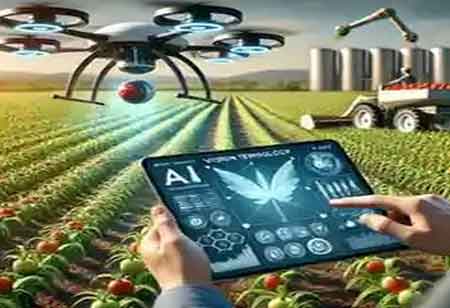Thank you for Subscribing to Agri Business Review Weekly Brief
AI Vision Solutions: Shaping the Future of Farming

By
Agri Business Review | Tuesday, April 01, 2025
Stay ahead of the industry with exclusive feature stories on the top companies, expert insights and the latest news delivered straight to your inbox. Subscribe today.
The agricultural landscape is experiencing a profound shift as technology becomes integral to modern farming practices. Among the most impactful innovations is the rise of AI-powered harvest vision solutions, which are revolutionizing how crops are monitored, managed, and harvested. These systems use artificial intelligence and advanced computer vision to give farmers real-time insights into crop health, growth patterns, and potential issues, enabling them to make decisions based on data, which improves efficiency and sustainability. As global demands for food production grow and environmental concerns heighten, AI-driven solutions are proving to be crucial tools in shaping the future of agriculture. From enhancing productivity to reducing resource waste, these technologies transform traditional farming into a smarter, more sustainable industry.
The State of AI-Powered Agricultural Innovation
The agricultural industry is undergoing significant transformation due to integrating advanced technologies. In particular, AI-based vision solutions have emerged as critical tools for optimizing farming practices. These technologies enhance harvesting efficiency, improve crop yield predictions, and enable precision farming. With AI-driven vision systems, farmers can monitor the condition of crops in real time, allowing them to take prompt actions to address issues such as pests, diseases, and nutrient deficiencies. This integration is transforming traditional farming into a more data-driven, intelligent approach. As the world increasingly prioritizes sustainability and resource efficiency, AI-powered harvest vision solutions are emerging as indispensable tools in modern agriculture.
Obstacles and Resolutions in AI Harvest Vision Technology
While AI harvest vision solutions hold immense potential, several challenges must be addressed to unlock their benefits. One significant hurdle is integrating these systems with existing farming equipment and practices. Many farms operate with machinery not originally designed to accommodate AI technology. This can result in difficulties in data synchronization, processing delays, and even system malfunctions. Addressing these challenges requires the development of more versatile and compatible software platforms alongside hardware that allows for easier integration with diverse farming environments.
Another challenge lies in the accuracy of AI models, particularly regarding visual recognition and real-time decision-making. In some cases, the technology may struggle to differentiate between different crop types, weeds, or varying stages of crop growth. This issue can lead to misidentification, ultimately affecting the system's effectiveness. The solution is continuous improvements in machine learning algorithms, leveraging a more extensive dataset, and enhancing the training processes to help the AI system become more reliable in various agricultural settings.
Data security and privacy are additional concerns, as AI vision solutions rely heavily on large-scale data collection from farms. The vast amount of information gathered can expose farms to cybersecurity risks, potentially jeopardizing the sensitive details of production cycles, crop health, and yield forecasts. Implementing stronger encryption protocols, conducting regular audits, and ensuring compliance with privacy regulations can alleviate these concerns and maintain the trust of stakeholders.
Growing Potential and Benefits for Agricultural Stakeholders
AI harvest vision solutions provide farmers, researchers, and agribusinesses vast opportunities by creating more efficient, cost-effective, and sustainable agricultural practices. By automating crop monitoring and harvesting, these technologies save time and reduce labor costs. They help optimize resources such as water, fertilizers, and pesticides, thus contributing to more sustainable farming practices. Farmers can benefit from more accurate insights into crop health, enabling them to make well-informed decisions that ultimately enhance the quality and quantity of the harvest.
For agribusinesses, AI vision technology can predict crop yields more accurately, reducing the risk associated with overproduction or underproduction. This forecasting capability allows for better supply chain management and inventory control, leading to more efficient and cost-effective distribution. It can help identify market trends and consumer preferences, allowing agribusinesses to align their production strategies with demand, ensuring greater profitability.
Advancements in AI-powered vision solutions are expanding the opportunities for precision farming. Combining machine learning algorithms with computer vision allows these systems to map and analyze fields accurately. They can detect micro-variations in soil health, moisture levels, and plant growth, allowing farmers to tailor interventions based on specific needs in different parts of a field. This personalized approach reduces resource waste and increases overall productivity, benefiting the farmers and stakeholders throughout the supply chain.
As AI harvest vision systems evolve, they also promote sustainability in agriculture. With their ability to monitor crops in real-time and detect issues early on, such as pest infestations or diseases, these systems enable farmers to act quickly, reducing the need for excessive pesticide use. This shift toward precision pest management minimizes environmental impact while maintaining the integrity of the ecosystem. As these technologies become more advanced, the potential for improving soil health, reducing water consumption, and limiting greenhouse gas emissions increases, aligning with global sustainability goals.
AI vision solutions foster collaboration between different stakeholders in the agricultural sector. Data generated by these systems can be shared across various platforms, providing farmers access to valuable insights and benchmarks. This collaborative approach encourages knowledge-sharing, which helps improve agricultural practices globally. Researchers can leverage the data to identify new patterns and innovations, while policymakers can use the information to develop more informed regulations that support sustainable agricultural practices.





